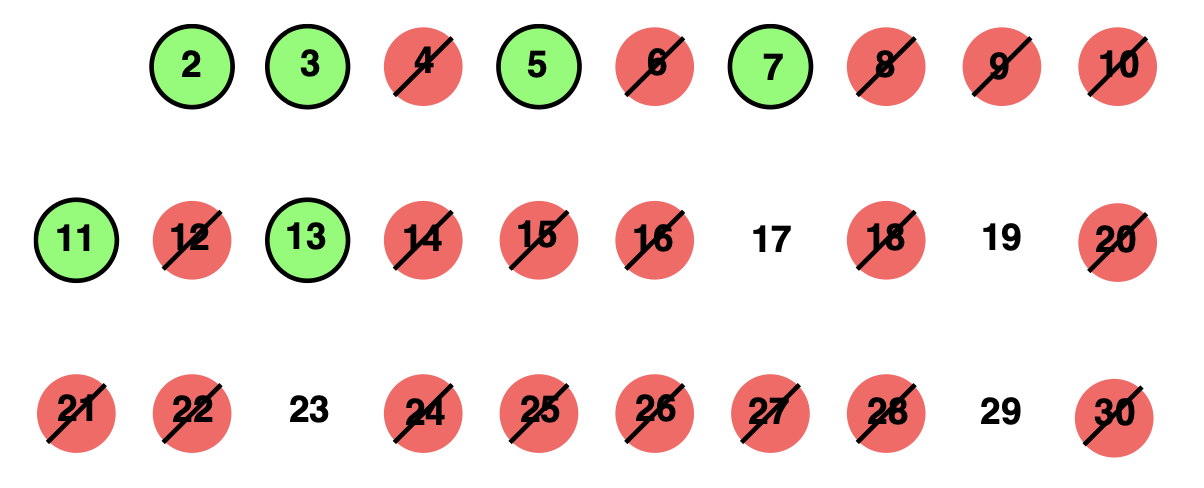1.1: Divisors and Congruences
- Page ID
- 60294
Definition 1.1
Given two numbers \(a\) and \(b\). A multiple \(b\) of \(a\) is a number that satisfies \(b = ac\). A divisor \(a\) of \(b\) is an integer that satisfies \(ac = b\) where \(c\) is an integer. We write \(a|b\). This reads as \(a\) divides \(b\) or a is \(a\) divisor of \(b\).
Definition 1.2
Let \(a\) and \(b\) non-zero. The greatest common divisor of two integers \(a\) and \(b\) is the maximum of the numbers that are divisors of both \(a\) and \(b\). It is denoted by \(\gcd(a, b)\). The least common multiple of \(a\) and \(b\) is the least of the positive numbers that are multiples of both \(a\) and \(b\). It is denoted by \(\mbox{lcm}(a ,b)\).
Note that for any \(a\) and \(b\) in \(\mathbb{Z}\), \(\gcd(a, b) \ge 1\), as 1 is a divisor of every integer. Similarly \(\mbox{lcm} (a, b) \le |ab|\).
Definition 1.3
A number \(a > 1\) is prime in \(\mathbb{N}\) if its only divisors in \(\mathbb{N}\) are \(a\) and 1 (the so-called trivial divisors). A number \(a > 1\) is composite if it has more than 2 divisors. (The number 1 is neither.)

Figure 1. Eratosthenes’ sieve up to \(n = 30\). All multiples of a less than \(\sqrt{31}\) are cancelled. The remainder are the primes less than \(n = 31\).
An equivalent definition of prime is a natural number with precisely two (distinct) divisors. Eratosthenes’ sieve is a simple and ancient method to generate a list of primes for all numbers less than, say, 225. First, list all integers from 2 to 225. Start by circling the number 2 and crossing out all its remaining multiples: 4, 6, 8, etcetera. At each step, circle the smallest unmarked number and cross out all its remaining multiples in the list. It turns out that we need to sieve out only multiples of \(\sqrt{225} = 15\) and less (see exercise 2.4). This method is illustrated if Figure 1. When done, the primes are those numbers that are circled or unmarked in the list.
Definition 1.4
Let \(a\) and \(b\) in \(\mathbb{Z}\). Then \(a\) and \(b\) are relatively prime if \(\gcd(a, b) = 1\).
Definition 1.5
Let \(a\) and \(b\) in \(\mathbb{Z}\) and \(m \in \mathbb{N}\). Then \(a\) is congruent to \(b\) modulo m if \(a+my = b\) for some \(y \in \mathbb{Z}\) or \(m | (b-a)\). We write
\[\begin{array}{ccccc} {a = _{m}b}&{\mbox{or}}&{a = b \mod m}&{\mbox{or}}&{a \in b+m \mathbb{Z}} \end{array} \nonumber\]
Definition 1.6
The residue of \(a\) modulo \(m\) is the (unique) integer \(r\) in \(\{0, \cdots, m-1\}\) such that \(a = _{m}r\). It is denoted by \(\mbox{Res} _{m}(a)\).
These notions are cornerstones of much of number theory as we will see. But they are also very common in all kinds of applications. For in- stance, our expressions for the time on the clock are nothing but counting modulo 12 or 24. To figure out how many hours elapse between 4pm and 3am next morning is a simple exercise in working with modular arithmetic, that is: computations involving congruences.


